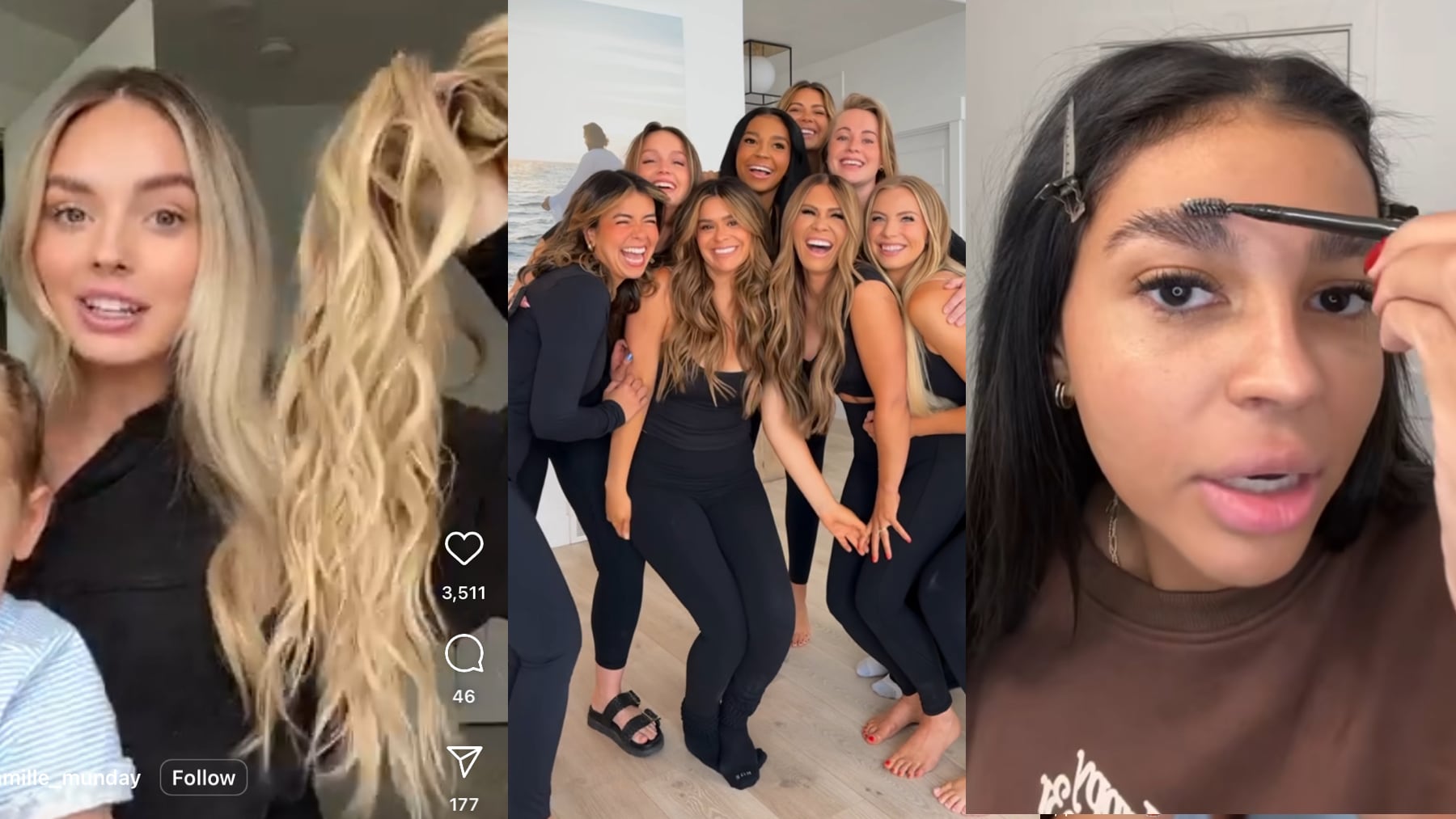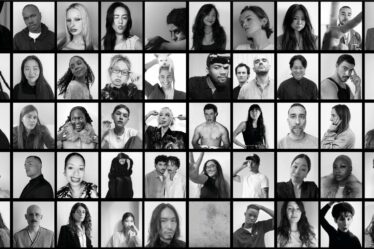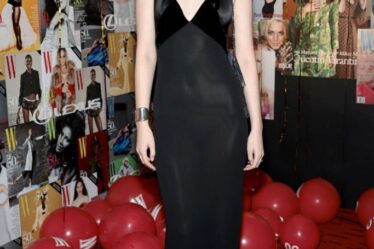
As a 23-year-old stay-at-home mom in Utah in 2019, Camille Munday was missing her days as a dancer. And then her little brother introduced her to TikTok.
“Since I was a mom, wife, I couldn’t really dance at studios anymore, so I just started dancing on TikTok,” she said. “Being a stay-at-home mom, I wanted something to have as my own and a hobby.”
Nowadays, she’s an influencer with 1.7 million followers, inundated with comments from fans begging her to join the cast of the hit Hulu show “The Secret Lives of Mormon Wives” thanks to her previous membership in its now infamous #MomTok group. She said she has no plans to do so — but her social media career, however, will certainly continue.
Already a formidable presence on Instagram and TikTok, Utah-based influencers — known for their wavy long hair, matching workout sets and Stanley cups — have taken over reality TV with “Mormon Wives.” The buzz around the new Hulu show — which revolves around a group of Mormon TikTok influencers fighting to rehabilitate their image after a salacious swinging scandal went viral in 2022 — has propelled it to become the top unscripted show of the year on the streaming platform, even topping the Kardashians’ series.
But while reality TV is known for creating newly minted influencers, the women of “Mormon Wives” were already there. The show’s stars already had millions of followers between them ahead of its premiere, bringing in fashion, beauty and lifestyle brand deals. The show, though, is putting the mainstream spotlight on Utah’s powerful influencer community, which has long existed online, driving shopping trends by selling a seemingly ideal lifestyle.
While a segment of Mormon influencers like Utah-based Hannah Neelman of Ballerina Farm have recently been the subject of online fascination (and debate), the “Mormon Wives” group is a far-cry from the “tradwife” set. Instead of baking bread and churning butter in prairie dresses and aprons, the show’s cast — and countless other similar influencers in the state — are more likely to be driving their SUV to their Botox appointment wearing Lululemon athleisure. Instead of milk straight from the cow, their drink of choice is Salt Lake City’s Mormon-friendly alternative to iced coffee — 44-ounce sodas laced with sugary syrup flavours.
“I can tell when someone’s from Utah just by their fashion,” said Munday.
They’re also part of a powerful group that has been at the forefront of influencer culture since the late aughts — before the word even existed. Influencers based in Utah, which is over 60 percent Mormon, drive $250 million worth of sales annually for influencer monetisation platform LTK, or 5 percent of its $5 billion in global sales. (For comparison, Utah residents account for just 1 percent of the overall US population.) Many launch fashion and beauty brands, some of which go on to gain international recognition, including formerly Mormon and Utah-based influencer Amber Fillerup Clark’s hair-care brand Dae and influencer sisters Brooklyn and Bailey McKnight’s skincare brand ITK.
Their appeal is relatively simple: They broadcast a picture-perfect ideal of American motherhood, even if it doesn’t always line up with reality. Utah influencers “look really put together. They might be struggling on the inside, but it is that kind of like, ‘Wow, she gets up every day, she does her hair, she puts makeup on, puts on a cute outfit.’ Even if it’s a gym outfit, it’s colour-coordinated; her Stanley cup matches her outfit. There’s still some aspiration of being a mom, being a wife, but looking good,” said Ciele Cosmetics co-founder and CEO Nikki DeRoest, a celebrity makeup artist who began her career in Utah before moving to Los Angeles.
Selling the American Dream
Modern-day Mormons pioneered influencer culture as we know it. They were encouraged directly by religious leaders to create content online as early as 2007, when one of the Church’s most senior leaders M. Russell Ballard told Brigham Young University graduates in a commencement speech to write blogs and create other forms of “new media.”
They were at the forefront of the “mommy blogging” craze of the 2000s, with blogs like Naomi Davis’ Rockstar Diaries and Natalie Lovin of Nat the Fat Rat gaining traction online. Fashion and lifestyle bloggers like Rachel Parcell and her sister Emily Jackson were among the first to monetise their websites, sharing product recommendations alongside aspirational photos of their home life. As Instagram replaced blogs as the primary method for reaching readers, their curated pastel aesthetic transferred seamlessly to the platform, where they shared clothes, beauty products and other household goods to moms searching for ways to optimise their stressful lives.
“It’s an idealised version of life in the Mormon culture, the woman stays home, she takes care of the kids,” said Mariah Wellman, an assistant professor at Michigan State University who researches influencer culture. “Why are so many Mormon women wanting to be influencers? It’s because they can do all the things that their prophet says that they should do, which is, stay home, but they can also provide for their family in really lucrative ways through affiliate marketing and sponsored content.”
In 2020, the future cast of “Secret Lives” emerged as part of a new generation of Mormon social media moms, taking the phenomenon to TikTok. The show’s star, Taylor Frankie Paul (who published the swinging scandal in a 2022 TikTok live video) dubbed her Salt Lake City-based group #MomTok, earning massive engagement with TikTok-style dances. The fantasy they were creating was the same as their predecessors: young, beautiful, and happy with a husband and children in a well-appointed house.
Beauty spending is also a big part of life in Utah. The Church of Jesus Christ of Latter-Day Saints believes the body is sacred, and chasing physical perfection is a major part of culture in the state. According to DeRoest, the popularity of beauty procedures including injectables, lash extensions, hair extensions and plastic surgery is akin to that in the similarly image-obsessed Los Angeles.
“That’s why influencers do so well there, because the audience in Utah craves trends,” said DeRoest.
MomTok’s New Reality
“Mormon Wives” may have catapulted Mormon influencers into the mainstream, but it’s also shattered some of the illusion of domestic bliss. On screen, cast members not only bicker with each other in typical reality TV fashion, but they also share heavier experiences, such as an ectopic pregnancy, as well as emotional and even physical abuse.
That image has long been fading. Original mommy blogger Lovin got divorced in 2016, while Parcell has been open about her own fertility struggles. And as the “Mormon Wives” cast points out multiple times throughout the show, they’re all the breadwinners of their families.
“Instagram was just more about the aesthetic of your page,” said Munday. “I don’t think people really dove into the real, raw side of their lives.”
It’s part of why Ballerina Farm’s Neelman has become such a lightning rod online — audiences don’t accept portrayals of perfection without question anymore. There are even online parodies — “Utah mom” TikTokker Jane Williamson has built a following while poking fun at the culture of consumerism and competitive perfectionism among the state’s influencers.
That shift hasn’t necessarily put a dent in Utah influencers’ businesses. If anything, this new prominence has increased their status: since promotions for the show started airing this spring, Google searches for the signature “Utah curls” — a wavy curl that goes straight at the bottom — reached an all-time high. And after the show premiered earlier this month, LTK searches for curling irons are up 95 percent. A swipe through the cast’s Instagram Stories show a stream of sponsored beauty treatments and unboxings from hair, skin and cosmetics brands such as Crown Affair, L’Occitane, RMS Beauty and Saltair. Influencer marketing agency CreatorIQ data shows that the earned media value of posts with the #momtok hashtag have surged since the show was announced in May.
“The assumption about Mormons is that they are squeaky clean; brands consider them to be a low-risk partnership,” said Wellman. Munday admits that her brand deal count saw a “bit of a dip” in the aftermath of Paul’s bombshell TikTok live, but that has since recovered.
Indeed, now, as they reach a new level of fame, “the brands are crawling back,” said Wellman.
Sign up to The Business of Beauty newsletter, your must-read source for the day’s most important beauty and wellness news and analysis.



